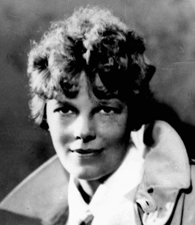Amelia Earhart set the gold standard for “enlightened feminism.” She was dubbed “Lady Lindy” because of her likeness to aviator Charles Lindbergh, and because her solo flight across the Atlantic was second only to his own. Although the mystery of her disappearance overshadows her life’s work, her artless charm, compassion and boundless daring endeared her to men and women across the globe.
Amelia Earhart’s Early Days
Amelia Mary Earhart was born in Atchinson, Kansas, on July 24, 1897, to Amy Otis Earhart and Edwin Stanton Earhart. Edwin, a railroad attorney, constantly moved the family across the Midwest.
After high school, Earhart enrolled at the Ogontz School, near Philadelphia, but decided to drop out to join the war effort as a nurse in February 1918, treating wounded soldiers in a Toronto hospital. She often visited a nearby airfield and grew interested in flying.
After World War I, Earhart attended Columbia University as a pre-med student but didn’t finish, and moved to California at the request of her parents. It was here that she took her first ride in an airplane and scraped together money to take flying lessons.
Sources in this Story
- Purdue University: Amelia Earhart Biographical Sketch
- Amelia Earhart Birthplace Museum: Biography of Amelia Earhart
- PBS: American Experience: Timeline: Amelia Earhart, 1897-1937
- findingDulcinea: On This Day: Amelia Earhart Embarks on Solo Atlantic Flight
- Smithsonian Magazine: Will the Search for Amelia Earhart Ever End?
- Smithsonian Institution: National Air and Space Museum: Women in Aviation and Space History: Amelia Earhart
- The New York Times: The Lady Vanishes: Amelia Earhart
Earhart’s Aviation Accomplishments
In 1922, according to the Amelia Earhart Birthplace museum, Earhart bought her first airplane: a used Kinner Airster. She became the first woman and only 17th pilot to get her National Aeronautics Association pilot’s license in 1923.
She set the women’s altitude record in 1923, and in 1928 was offered the opportunity by publicist George Putnam—her future husband—to take part in a trans-Atlantic flight that June. Flying as a passenger with pilot Wilmer “Bill” Stultz and co-pilot/mechanic Louis E. “Slim” Gordon, she became the first woman to cross the Atlantic Ocean by plane. After the flight Putnam published a book written by Earhart about the event, “20 Hrs., 40 Min.”
Earhart went on to set several records, including the women’s speed record in 1930, and became the first American woman to fly an autogiro. In 1931, she formed the Ninety-Nines, the first organization of female pilots, with 98 other aviatrixes.
In May 1932, she flew solo across the Atlantic, and was just the second person to make such a flight, following Charles Lindbergh in 1927. She received a tickertape parade in New York and being awarded a National Geographic Society medal by President Hoover and the Distinguished Flying Cross by Congress.
She was also the first woman fly solo roundtrip across the United States, was the first person to solo fly from the United States to Hawaii, as well as the first person to fly solo from Los Angeles to Mexico City.
In 1937, having set many records already, Earhart was looking to beat a distance flying record by flying around the world near the equator. During her first attempt at the flight she damaged the landing gear and had to have the plane, the Electra, sent to California for repairs. Her second attempt at the flight began on May 21, 1937, with her navigator, Fred Noonan.
On July 2, 1937, she left Lae en route to the small Pacific island of Howland. The flight should have taken 17 to 19 hours, and her fuel reserve, according to engineers, should have lasted 24 to 27 hours.
A Coast Guard ship was near Howland waiting for Earhart, but she did not communicate with them at the agreed-upon intervals, possibly because of the ship’s location in a time zone that had a half-hour offset, according to Smithsonian Magazine. The ship did receive some of her transmissions, and at one point, it appeared she was quite close, but the plane was never seen again. The Coast Guard ship immediately started searching the water, and was joined over the next few days by two battleships.
Purdue University’s George Palmer Putnam Collection of Amelia Earhart Papers is the world’s largest collection of Amelia Earhart papers, photos, memorabilia and artifacts.
The Mystery and Legacy of Amelia Earhart
The remains of Earhart’s plane were never recovered, and speculation about her disappearance has only increased over the years.
“Earhart’s disappearance spawned countless theories involving radio problems, poor communication, navigation or pilot skills, other landing sites, spy missions and imprisonment, and even living quietly in New Jersey or on a rubber plantation in the Philippines,” according to the National Air and Space Museum. “The most reasonable explanation, based on the known facts of her flight, is that they were unable to locate Howland Island, ran out of fuel, and ditched into the Pacific Ocean.”
The tragic and mysterious end of her life has at times overshadowed her accomplishments, for which she is remembered as an aviation pioneer and feminist icon. In a 1996 New York Times Magazine article, author Camille Paglia wrote, “Amelia Earhart symbolizes modern woman’s invasion of the male world of daring action and adventure. … Dashing in man-tailored shirts, jackets and slacks, Earhart became an icon of the rapidly evolving new woman who sought self-definition and fulfillment outside the home.”
The PBS American Experience documentary “Amelia Earhart” can be viewed online.
This article was originally written by Shannon Firth; it was updated June 17, 2017.











